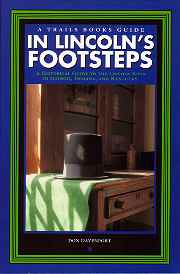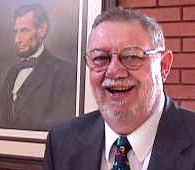Home | News | Books | Speeches | Places | Resources | Education | Timelines | Index | Search
So what is it like to travel in the heart of Lincoln country? Whether you're an armchair traveler or need a hands-on travel guide to historic Lincoln sites, author Don Davenport can give you insights. His latest book is an updated version of his popular guide to places where Lincoln lived and visited in the Midwest. In Lincoln's Footsteps is packed with photos and historical information, plus details for quick stopovers, weekend getaways or family vacations.

Author Interview
Don Davenport, Author
In Lincoln's Footsteps: A Historical Guide to the Lincoln Sites in Illinois, Indiana, and Kentucky
Trails Books, January 2001
ISBN 1-931599-05-X, $18.95, softcover

Don Davenport was an award-winning travel writer and photographer who lived in Wisconsin. He grew up in Freeport, Illinois, a community famous for its Lincoln-Douglas debate site, and was a long-time member of the Abraham Lincoln Association. He passed away in 2014. In February 2002 we talked to him about his travels through Lincoln country and how his Lincoln book has changed. ALO: When did you first get interested in Lincoln?
Don Davenport: I learned about the Freeport Lincoln-Douglas Debate in fourth grade. At about the same time, a Freeport author named Louise Neyhart wrote a short children's novel called Henry's Lincoln, about a young boy who went to the debate. The fact that Lincoln had been in Freeport, and that someone had written a book about it made a big impression on me.
ALO: Why did you write your first Lincoln travel book?
Don Davenport: I'm a travel writer, and in the course of my travels began to learn more about Lincoln. Articles I wrote about Springfield and other Lincoln sites did quite well. By the late 1980s I'd written three or four books, and writing a travel guide to Lincoln sites in the Midwest seemed the thing to do.
ALO: How important is it to get out and see these Lincoln places?
Don Davenport: I think it's very important. You can learn a tremendous amount by reading, but the sense of place and of the man is certainly heightened by visiting the Lincoln sites. It allows you to draw your own conclusions.
ALO: Which Lincoln sites have a special appeal to you?
Don Davenport: The Lincoln Home National Historic Site in Springfield, Illinois, is one of my favorites. Lincoln and his family lived there for nearly 17 years, so we see Lincoln as husband, father, homeowner and neighbor. When he was not traveling on legal business, Lincoln took care of his horse, cut firewood and milked the family cow like his neighbors. The mid-1980s restoration of Lincoln's home is amazing in its craftsmanship and historical accuracy. The result was a bright and airy home, with a significant number of original family furnishings, including the kitchen stove. An ongoing restoration around the home gives visitors a wonderful picture of Lincoln's home and neighborhood.
Another favorite, Lincoln Boyhood National Memorial, in Spencer County, Indiana, is, to my mind, really about Lincoln's birth mother, Nancy Hanks Lincoln. She's the mystery woman in the Lincoln saga. Lincoln rarely spoke of her, and there are no accurate accounts of what she might have looked like. The site has a lovely memorial building and a living history farm that gives an idea of how the Lincoln family lived at Little Pigeon Creek. But standing at Nancy Hanks Lincoln's grave site, which went unmarked for 60 years after her death, somehow drives home the pain of Lincoln's 14 years in Indiana, which he once described as "pretty pinching times."
I'm drawn to smaller, somewhat off-the-beaten-path sites and Mt. Pulaski Courthouse State Historic Site, in Mt. Pulaski, Illinois, certainly fills the bill. It's one of only two original courthouses remaining from Lincoln's circuit-riding days on Illinois' Eighth Judicial Circuit. The building dominates the town square, which was built around it. There are county offices on the first floor and a magnificently restored courtroom on the second level. Lincoln argued a case involving a self-rocking baby cradle here, and you can slip into a courtroom spectator's seat and imagine a twinkle in his eye when he won. Incidentally, the book's cover photo was taken in the judge's chambers here.
I'd have to say that Lincoln's New Salem State Historic Site at Petersburg, Illinois, is my all-time favorite. Lincoln grew from a rough-and tumble youth to a man during his years here, and many of the Lincoln legends —- true or false —- had their beginnings at New Salem. I like the log buildings, the smell of wood smoke, the demonstrations put on by the interpreters, the serenity of the village (on a quiet day). It's a great place to people watch.
ALO: What are some of your most memorable experiences in covering Lincoln sites?
Don Davenport: I've met a lot of people along the Lincoln trail over the years. Whether they've been historians, Lincoln re-enactors, site managers, interpreters or other tourists, they've all been willing and eager to share their knowledge of Lincoln. Some of them have become good friends.
One of the most dramatic incidents occurred several years ago. That's when the publisher of the first Lincoln travel guide rented a Lincoln Continental and drove me to our very first book signing at the Lincoln Home Visitor Center in Springfield. One of the local TV stations interviewed me at the book signing. It must have been a slow news day, because they featured nearly a minute of that interview on the Sunday night news. The next day, people in Springfield and New Salem stopped to say they'd seen me on TV. They were total strangers! I was absolutely stunned.
On a different note, I was surprised by the power of a plain bronze plaque I once saw on a boulder beside the Mississippi River. This marker in Dallas City, Illinois reads: "Lincoln spoke here, October 24, 1858." I found the simplicity of that statement touching.
I am constantly amazed at the high level of interest in Abraham Lincoln and at the staying power of that interest. Even newspaper and magazine articles about Lincoln bring calls and letters, often containing a tidbit of Lincoln history or references to a distant relative who saw or knew or had some contact with Lincoln. I think it's wonderful.
ALO: Have you seen any changes to Lincoln sites recently?
Don Davenport: Yes, quite a few. Charleston, Illinois has a new Lincoln-Douglas Debate Museum, and there's a new visitor center at the nearby Lincoln Log Cabin State Historic Site. The National Park Service acquired the Lincoln Boyhood Home in Hodgenville, Kentucky late last year.
In Springfield, the library portion of the Lincoln Presidential Library and Museum is scheduled to open late this year. The Vachel Lindsay Home has been reopened after being closed for some five years for renovation. A number of Lincoln sites have increased their programming. With the Lincoln Bicentennial coming up in 2009, I think you'll seen increasing upgrades and changes in Lincoln sites across the country.
ALO: What are some of the Lincoln places you added to this edition?
Don Davenport: The William Jones State Historic Site in Gentryville, Indiana; Lincoln stayed there in 1844. The Abraham Lincoln Long Nine Museum in Athens, Illinois, which has a fascinating name. The new Lincoln-Douglas Museum in Charleston, Illinois. Kellogg's Grove, near Kent, Illinois; Lincoln was there as a soldier in the Black Hawk War. The Aplington House, Polo, Illinois, where Lincoln spent some time in 1856. Plus, many other Lincoln sites in the book were expanded.
ALO: How do you hope readers will use your new book?
Don Davenport: I hope it will pique readers' interest and make them want to visit some of the sites. That's exactly why the book was written.
ALO: Where can people find the book?
Don Davenport: It is available in the U.S. from many bookstores, online sources, or by calling Trails Books in Black Earth, Wisconsin at 1-800-236-8088.
Home | News | Education | Timelines | Places | Resources | Books | Speeches | Index | Search Copyright © 2002 - 2020 Abraham Lincoln Online. All rights reserved. Privacy Policy
